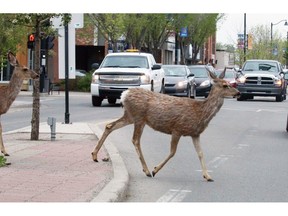The collaborative will share ideas to develop mitigation strategies for how to better coexist with non-domesticated animals, such as deer and coyotes.

Article content
Representatives from 10 Calgary-area municipalities will be putting their heads together to brainstorm solutions to interacting with conflict wildlife in their communities.
The Municipal Conflict Wildlife Collaborative — Calgary Area (MCWC-CA) is a recently formed group that includes staff from 10 municipalities, including Calgary, Airdrie, Okotoks, Cochrane, Canmore, the M.D. of Bighorn, Diamond Valley, Chestermere, Rocky View County and Wheatland County. The collaborative also has representatives from the Alberta government.
Advertisement 2
Article content
Article content
Meeting quarterly, members of the MCWC-CA will share ideas to develop mitigation strategies for how to better coexist with non-domesticated animals like deer, coyotes, beavers and other urban wildlife.
Craig Beaton, a member of the collaborative and the operations manager for the Town of Diamond Valley, said the group was the brainchild of Blair Kreiner, an integrated pest management technician with the City of Airdrie. According to Beaton, Kreiner reached out to various municipalities in the region to gauge interest in forming a taskforce committed to conflict wildlife mitigation.
The response was enthusiastic, and Beaton said the group held its first meeting last Tuesday.
“Obviously, each municipality has their own wildlife conflict issues,” he said. “There’s a long list of issues, but coyotes, deer … beavers — those seem to be some of the bigger issues.”
Other animals that were brought up at the first meeting included pocket gophers, raccoons and Canadian geese, according to Beaton.
Deer a growing concern in Okotoks
In the Foothills region south of Calgary, Beaton said the most common wildlife that residents have issues with are mule deer, which have proliferated in urban areas like Okotoks and Diamond Valley.
Article content
Advertisement 3
Article content
Christa Michailuck, the Town of Okotoks’ long-serving parks and recreation director, said public complaints about deer started around 2015. Before long, she said residents’ gripes with the animals started to escalate as more and more made their way into town, accessing Okotoks via the Sheep River corridor.
Public opinion on deer appears to be split among Okotokians, according to Michailuck. While half of the town’s residents enjoy seeing them, the other half are annoyed by the damage the animals can inflict on yards and gardens.
As more and more deer settled in town, Michailuck said the prevalence of people feeding them became an issue, which led to the deer becoming habituated to humans.
Eventually, Okotoks town officials realized they needed to find a solution to the growing deer problem. The town created an urban deer taskforce, and council passed a deer management strategy in 2021.
The strategy included a prohibition on feeding deer on private properties and amendments to the town’s land-use bylaw that allow residents to erect permanent deer-deterrent fencing to prevent the animals from leaping into their backyards.
Advertisement 4
Article content
But public education has been the main focus, according to Michailuck.
“We really needed to clean (public feeding) up first and get residents on board with helping deter deer from their yards or gardens before we considered other measures,” she said.
Despite the town-wide strategy, mule deer continue to multiply in Okotoks. According to Michailuck, a recent survey of the species revealed a population of roughly 145 mule deer in Okotoks town limits — six more than were recorded in 2023 and a record since the yearly count began in 2015.
Diamond Valley dealing with deer
Diamond Valley, located 20 kilometres west of Okotoks, has also appeared to develop a mule deer problem, and the local town council has discussed the burgeoning population multiple times in recent months.
The issue has caused gripes around town, as the deer are seen as not only pests, but also attractants for predators and a potential spreader of chronic wasting disease — a progressive, fatal disease of the central nervous system that can affect some animals.
In January, a Diamond Valley resident asked town council if a cull would be considered to help keep the animal’s population at bay.
Advertisement 5
Article content
While the town later said a cull is not under consideration (culls are also not within a municipality’s jurisdiction) council did unanimously approve a motion that directed staff to reach out to Alberta Fish and Wildlife to consider solutions to manage the town’s deer population.
Hot-button topics like how to appropriately handle the proliferation of urban deer are where the MCWC-CA will be useful according to Beaton.
“We can share ideas around communication and efforts imposed to try to resolve those conflicts, and share those successes or failures,” he said.
Alberta Fish and Wildlife did not respond to a request for comment.
Article content



